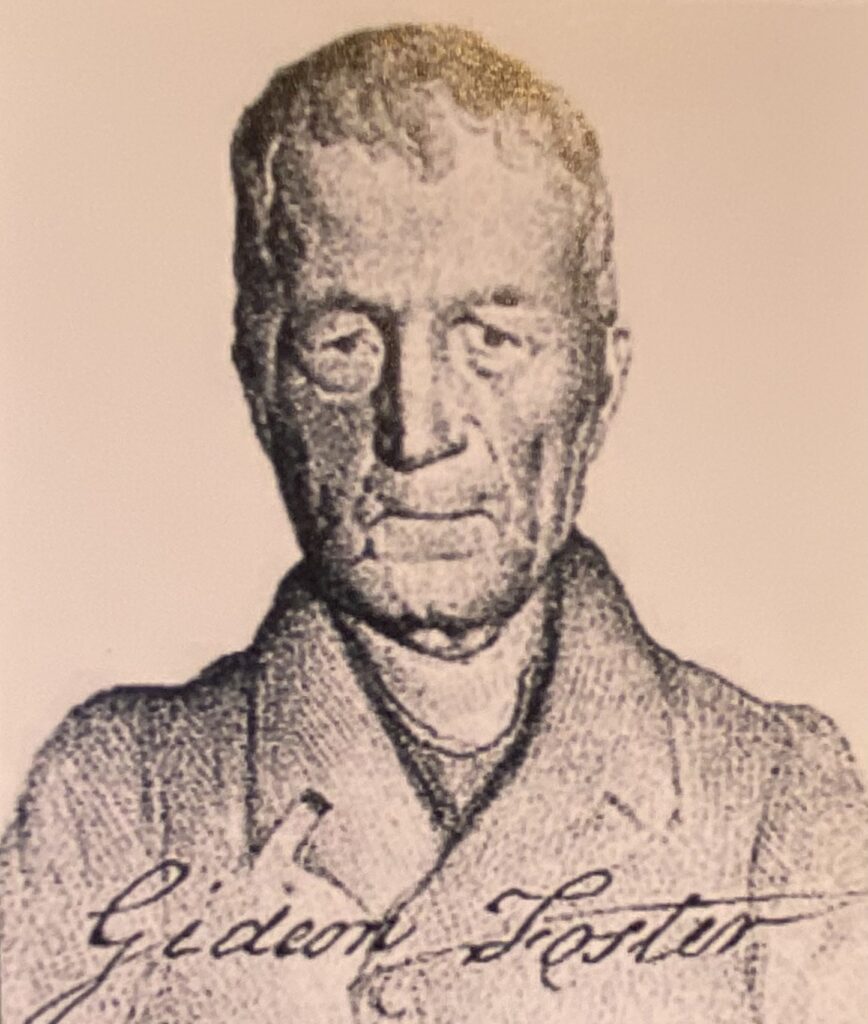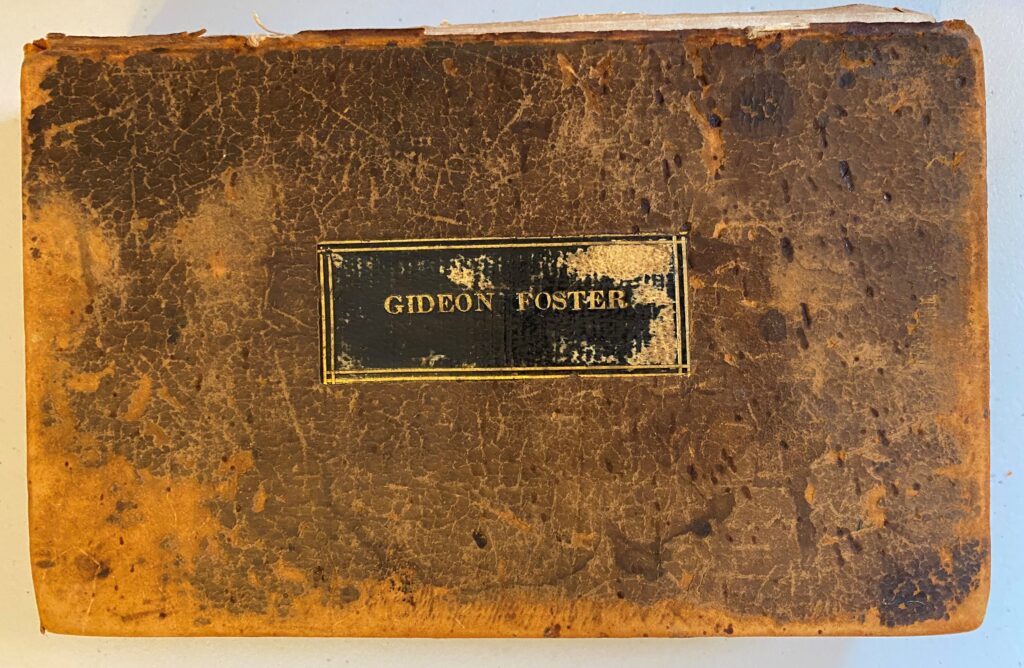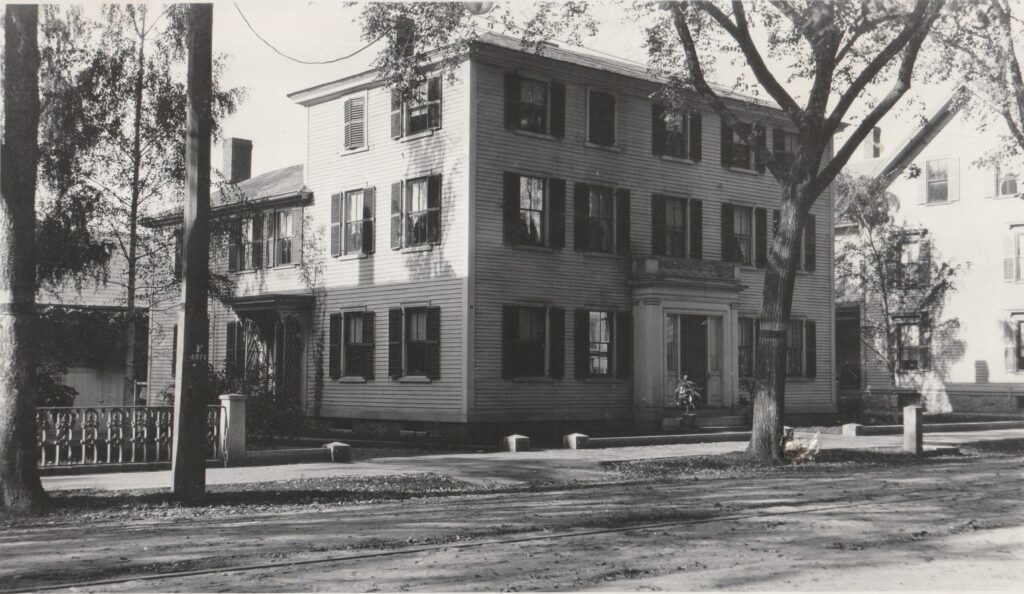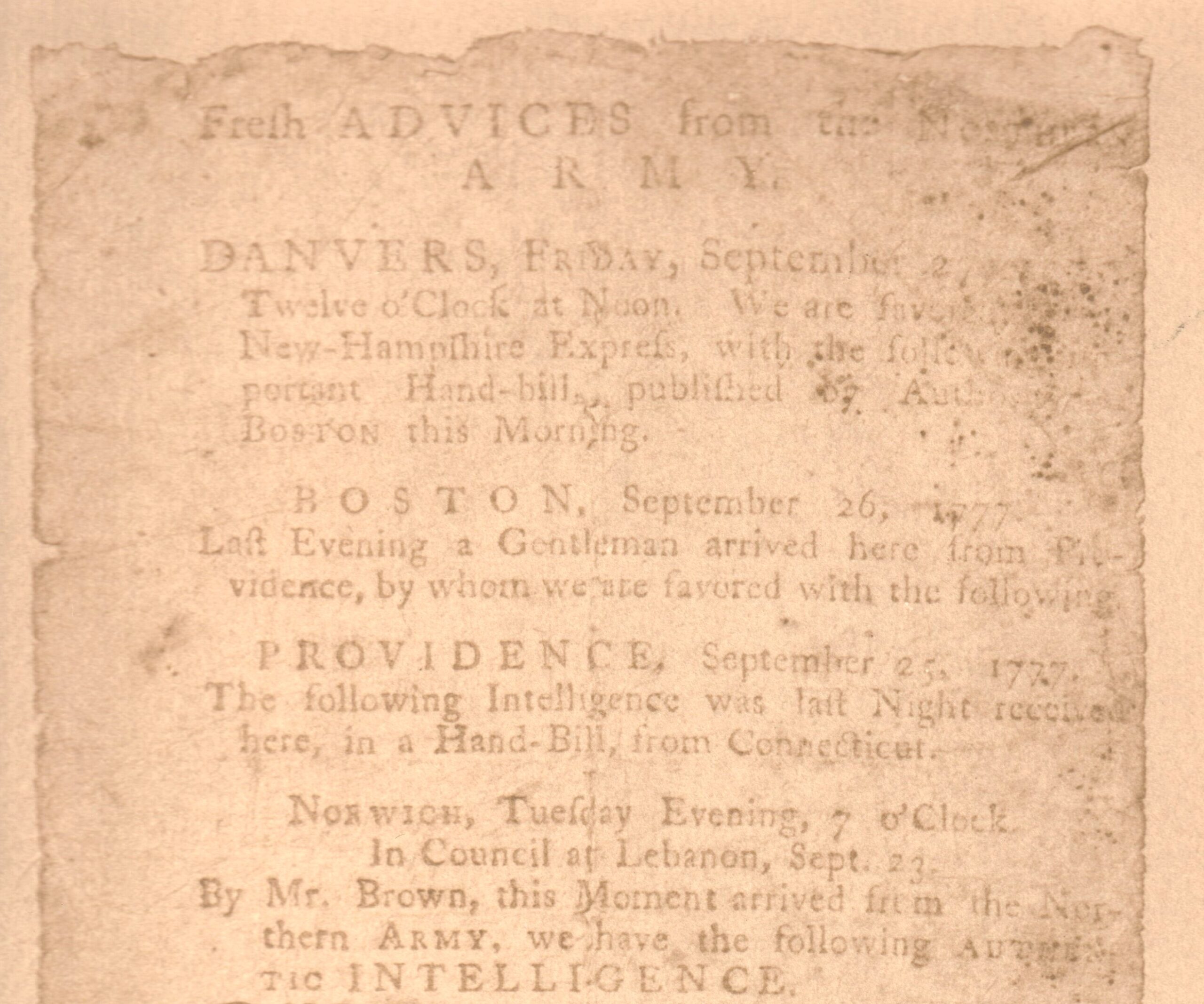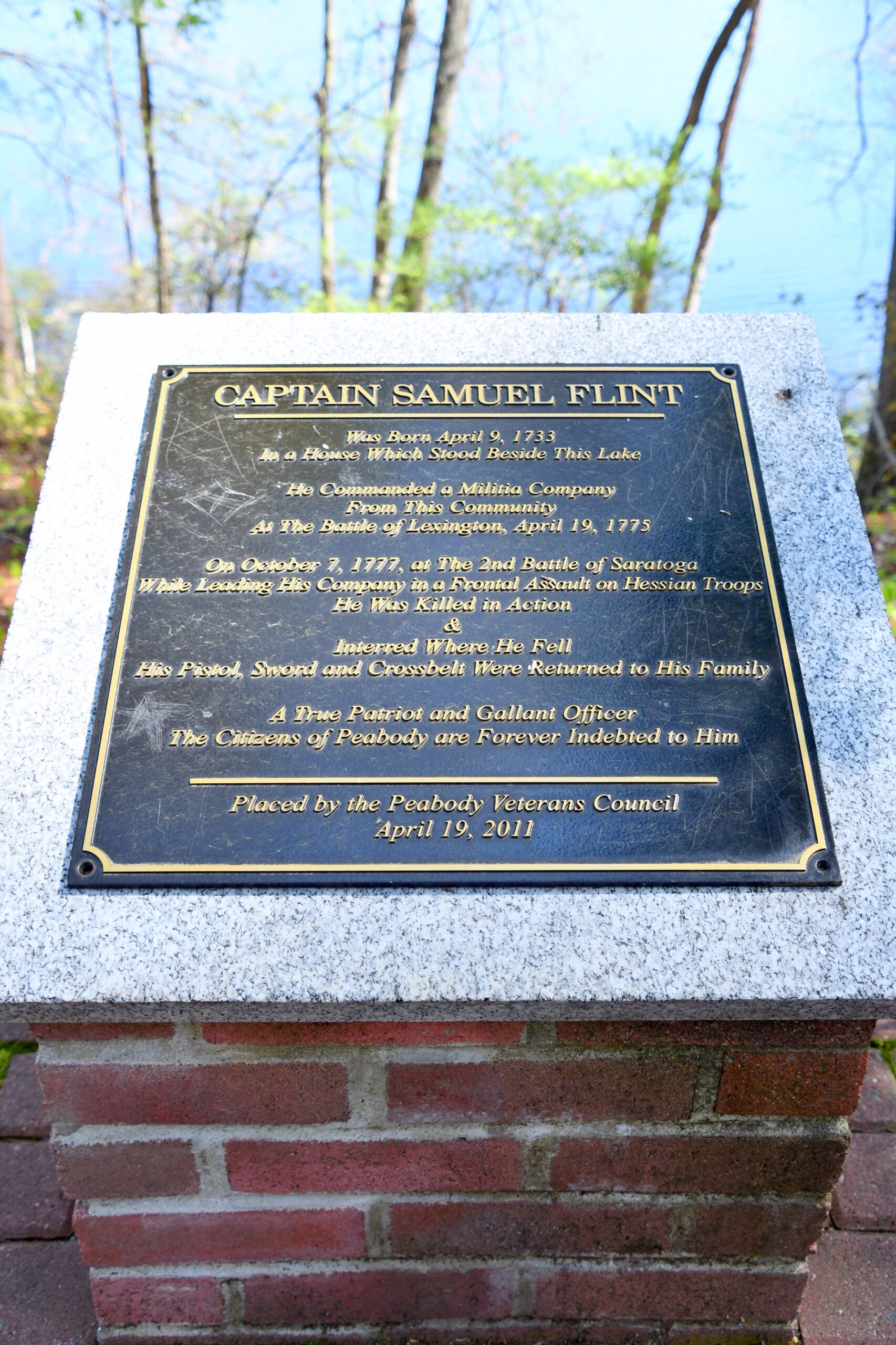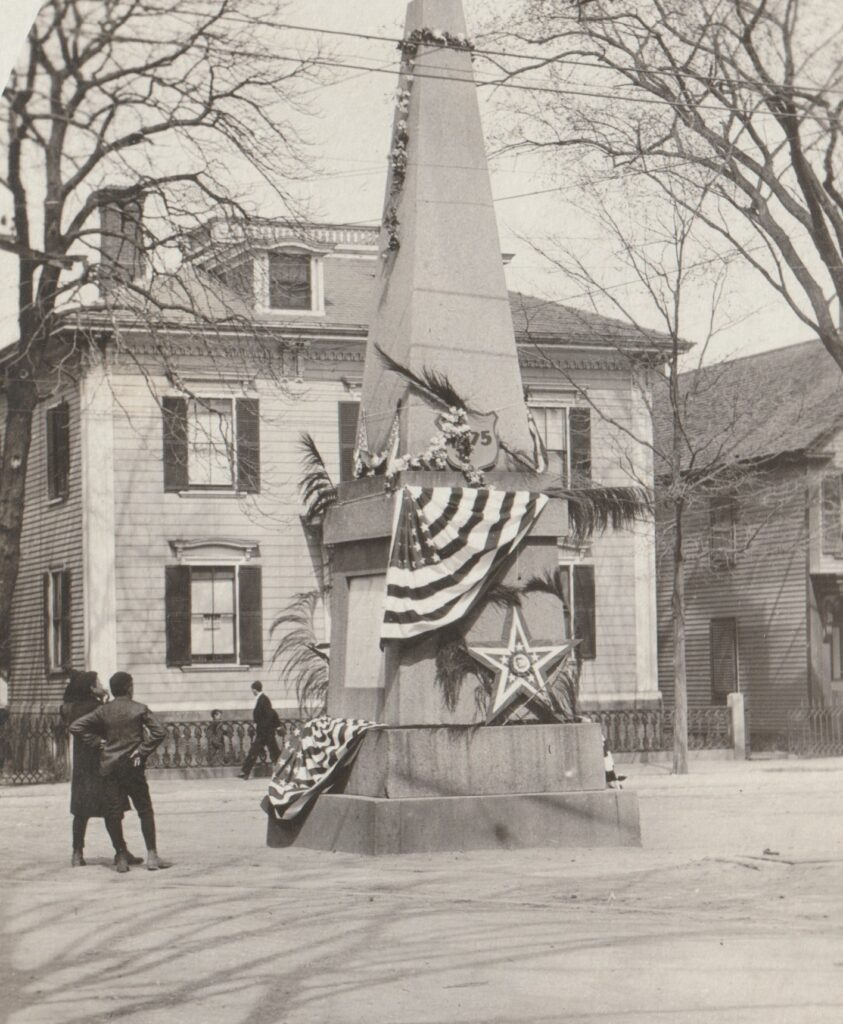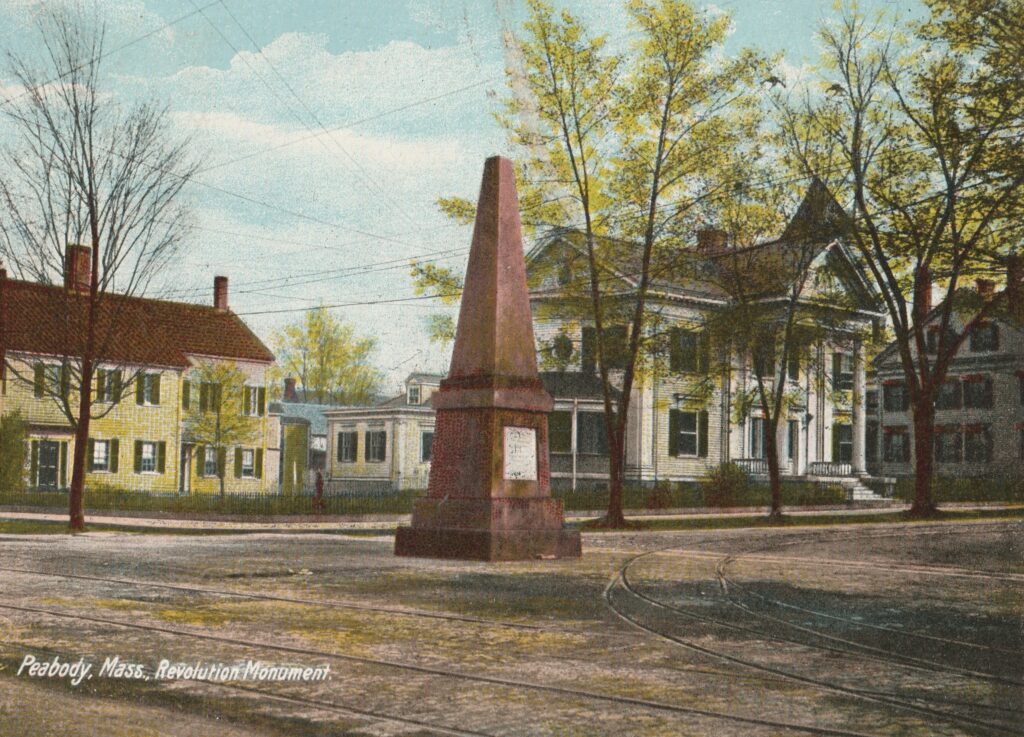This new page to our website will delve deep into Peabody’s important connection to the American Revolutionary War. It is a work in progress, and we hope you enjoy!

“Eagle Corner and Washington Street” by Charles Dole, 1828. This shows Main Street from approximately the corner of Washington Street, down to today’s Peabody Square.
Timeline
1757 – Official separation from Salem and incorporation of the Town of Danvers. Peabody was known as the South Parish of Danvers.
1765 – Stamp Act. Danvers (and Peabody) met to state their opposition to the Stamp Act and to ask Parliament for its appeal. Each town or district had stockpiles of gun powder and militia groups. A powder house was built on a hill off Tremont Street in 1765.
1768 – The people of the district, as did other towns, felt their civil rights had been threatened. As early as 1768, representatives from all communities met to deliberate these acts. The inhabitants of the Bay Colony were always aware of the need for protection from any aggression.
1770 – May 28, 1770 – Formal refusal of the people of Danvers to using or purchasing English goods; this showed solidarity with the merchants of the Port of Boston; a committee of 12 drafted this resolution and went door to door for signatures. Those who declined where noted as “enemies of the country.” This was in response to the Stamp Act and other new taxes.
1772 – Civil Liberties Resolution
1774 – On November 21, 1774, Danvers voted to uphold all resolutions of the Provincial Congress in repudiating the Acts of Parliament.
1775 – They also voted, on January 9, 1775, to arm and equip each man.
February 26: Leslie’s Retreat – Rev. Nathan Holt, of Old South Church, cut his sermon short and joined a company of men led by Capt. Samuel Epes. The British went to look for an ammunition store in Salem, Massachusetts. Col. Leslie, of the colonial militia, and the British forces did not engage in battle.
April 19: Battle of Lexington and Concord
June: Battle of Bunker Hill; Col. Pickering, of Salem, and his regiment pass the Bell Tavern in Peabody on their way to the Battle of Bunker Hill. Mrs. Anna Endicott spotted the Col. And said, “Why on earth don’t you march? Don’t you hear the guns in Charlestown?”
September 1: Benedict Arnold led 1,100 men to Quebec, passing through Lynn, County, Summit, Lowell, Prospect and Sylvan Streets on their way.
1776 – Declaration of Independence
1777 – First and Second Battle of Stillwater (September 19 -October 7) – Captain Samuel Flint, of now Peabody, killed October 7. This was a in important turning point in the war. It led to a formal alliance with France.
1778-1779 – Neither the Americans nor the British made any significant military gains.
May 1780 – British took Charleston, South Carolina
October 1780 -Americans won the Battle of King’s Mountain.
January 1781 – Americans won the Battle at Cowpens, South Carolina.
October 1781 – American won the Battle of Yorktown. British General Cornwallis surrendered.
1783 – The Americans and British finalized their peace negotiations. Both parties sign the Treaty of Paris – establishing America as an independent nation.
During war, 197 men from Peabody and Danvers served in Continental Army (total population 1,800).
The Importance of Patriot's Day
At 9AM on April 19, 1775, word came to Peabody that the British soldiers were marching toward Lexington and Concord. In preparation, the local minutemen had designated the corner of Main and Washington Streets as their meeting location. At that time, the local tavern, Bell Tavern was located at that corner.
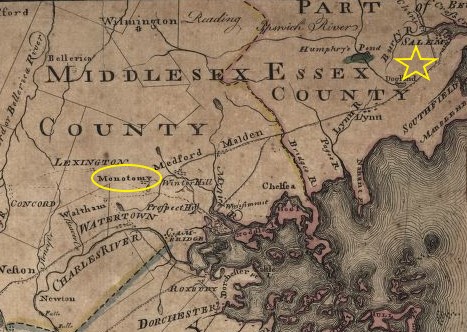
By 10AM, the minutemen had started their march towards Lexington. After 4 hours and 16 miles, they reached the village of Menotomy (the city of Arlington today). This map shows the distance between Danvers and Jason Russell’s House. We have added the yellow highlights for clarity.
The British troops were retreating from Lexington, and it was in Menotomy along Concord Road (now Massachusetts Avenue) that the minutemen encountered them. In these companies, there were over 300 men from Peabody, Danvers and Beverly. The minutemen took strategic cover, some behind walls and trees. They started to shoot at the retreating British troops. Unbeknownst to them, the British soldiers had flanked them. What followed was intense, close range fighting. A few of the Peabody soldiers took cover in the nearby home of Jason Russell (now the Arlington Historical Society). Some were pursued by British troops and killed.
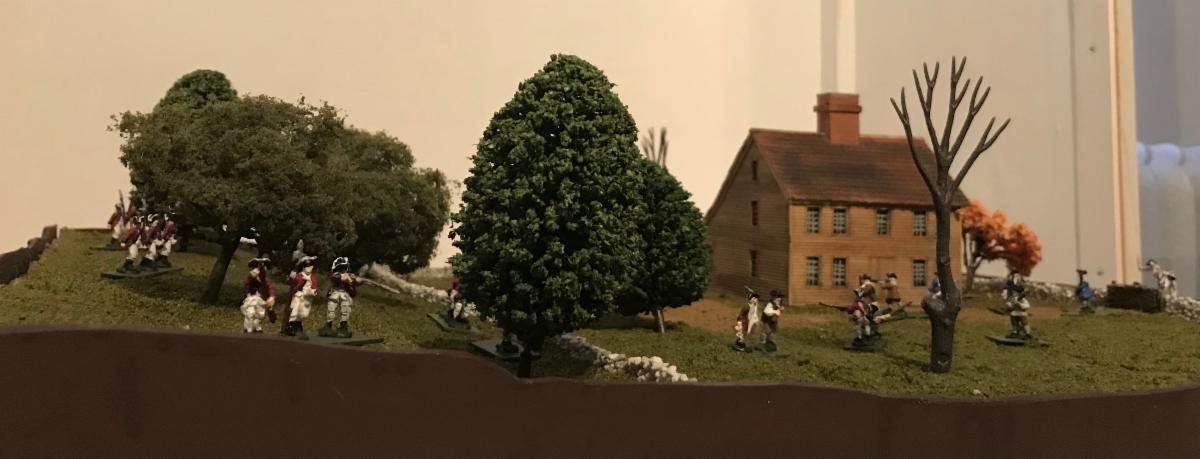
George Southwick was reluctant to join the minutemen that day, as his wife was close to giving birth. However, he could not find a replacement. George Southwick, Dennison Wallis and Joseph Bell found shelter in Jason Russell’s house. When it appeared the British soldiers had moved on, Southwick, Wallis and Bell emerged. However, they were surprised by British soldiers, and Southwick was struck in the head by an enemy sword. Wallis was shot multiple times, but miraculously survived by pretending to be dead. Bell was taken captive by the British and imprisoned two months on an English frigate. George Southwick, Samuel Cook, Henry Jacobs, Ebenezer Goldthwaite, and Benjamin Daland died in Arlington and resided in what it is today Peabody. Jotham Webb and Perley Putnam were also killed and lived in what it is today Danvers. At the time of their deaths, the men were all young, with much life before them. Samuel Cook was 33. George Southwick and Benjamin Daland were 25. Henry Jacobs, Ebenezer Goldthwaite and Jotham Webb were 22. Perley Putnam, the youngest, was 21.
The deceased were transported back to Peabody and Danvers via ox-cart. Samuel Cook, George Southwick, Henry Jacobs and Ebenezer Goldthwaite were taken to the home of Samuel Cook, 65 Central Street, to be waked. The funeral services took place in the South Congregational Church. George Southwick, Samuel Cook, Benjamin Daland and Ebenezer Goldthwaite were buried at the Old South Burial Ground on Main Street, near today’s border with Salem. Henry Jacobs was buried at his family’s cemetery in West Peabody.
Significant People and Places
General Gideon Foster (1749-1845)
- Engraving of Gideon Foster, March 7, 1836 Work of M. C. Torrey and B. F. Nutting
- Gideon Foster Psalm Book, 1827
- Gideon Foster House, circa 1916
The General Gideon Foster House is a historically, culturally and architecturally significant site for the city of Peabody. The Foster House was added to the National Register of Historic Places on June 23, 1976. It is located in the Washington Street District, which was designated to the National Register of Historic Districts on September 12, 1985. It was built in 1810 by John Saunders and sold to General Gideon Foster on May 22, 1815. The General Gideon Foster House is vital to Peabody’s history for multiple reasons. First, it was the home of prominent citizen Gideon Foster. He was born on February 24, 1749, to Lydia Goldthwaite and Gideon Foster. The Goldthwaite family settled in the Foster Street area of Peabody around 1700. Gideon Foster was 26 years old at the dawn of the American Revolution. Ten days prior to the Battle of Lexington, he was named Captain of Peabody’s Minutemen. On April 19, 1775, Foster led his men to West Cambridge, now Arlington. His company traveled sixteen miles, and the journey took four hours. Once there, they fought valiantly at the Battle of Menotomy, at the homestead of Jason Russell. The British troops were retreating from the Battle of Lexington and attempting to return to downtown Boston. The fighting was bloody and at close range. Seven Danvers and Peabody men gave their lives at this Battle. Foster’s men were outnumbered and flanked at all sides by British troops. However, they inflicted many injuries as the British troops passed. Foster led his company admirably. In addition, Foster delivered ammunition to Charlestown during the Battle of Bunker Hill, and he also fought at the Siege of Boston. Foster continued to serve with distinction and rose in the military ranks after the Revolutionary War. He was made Colonel in 1792, Brigadier General in 1796 and Major General in 1801. During this time, he also held political office. He was town clerk from 1791 to 1794. Foster was elected as the Representative to the General Court in 1796, and from 1799 to 1806. In his professional life, he was a successful businessman. He harnessed Goldthwaite’s Brook to power three mills: a bark, grist and chocolate mill. Foster left a positive impact on his community and was well regarded upon his death at the age of ninety-seven on November 1, 1845.
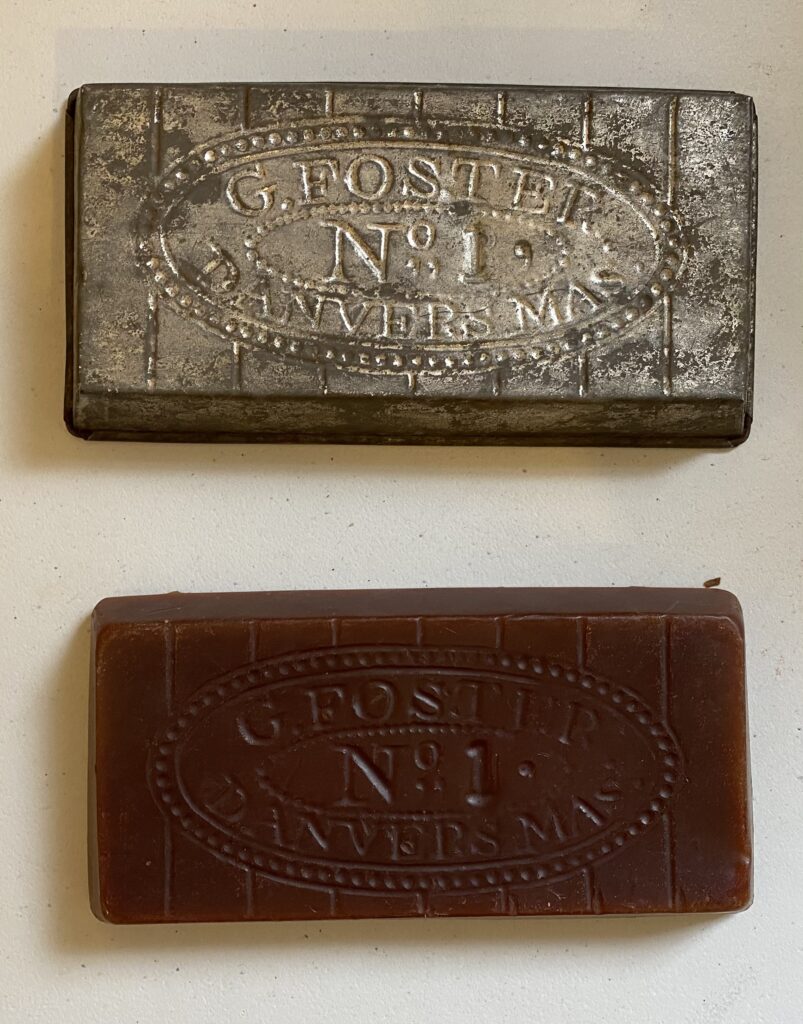
Tin chocolate mold used by Foster family starting in the 1750s
Rev. Nathan Holt (1725-1792)

The Reverend Nathan Holt was born on February 28th, 1725 to Nicholas and Dorcus Holt of Andover, Massachusetts. He graduated from Harvard College in 1757 with training as a minister. He married Sarah Abbott on August 4th, 1757. The following August, he was offered the position of pastor of the South Church in Danvers (now Peabody), with an annual salary of 80 pounds. The Holts had 3 children – Sarah (1758-1841), Mary (1761-1850) and Hannah (1769-1857). Rev. Holt remained at this parish his entire career, about 35 years. He prayed with the local minutemen when they went off to battle on April 19, 1775. He gave the sermons at the funerals the men who did not return that day. He was an ardent supporter of the Patriot’s cause. He died on August 2, 1792, and was buried at the Old South Burying Ground.
Private Peter Buxton
Peter Buxton was a Revolutionary soldier from Danvers. He served in 1780 under the command of Captain Benjamin Warren. Buxton is one of the Black soldiers from Danvers who served and was represented in the historical record.
Private Prince Buxton
Prince Buxton was a soldier who served under Captain Eleazar Lindsey’s Co, which included Lieutenant Daniel Galeucia and Col. Benjamin Ruggles Woodridge. Buxton enlisted on May 29th, 1775 and mustered August 1st, 1775. Buxton is one of the Black soldiers from Danvers who served and was represented in the historical record.
Private Zachariah Bray
Zachariah Bray was a soldier for Danvers, for 6 months and 12 days. He mustered July 1780 and enlisted July 8, 1780. He served under Captain Samuel Flower’s Co., Captain Joseph Crocker and Col. John Greaton’s regiment. He was at Camp Totoway and West Point. He was discharged December 14, 1780. He is listed on the 1790 Census as “all other free persons”.
Captain Samuel Flint (1733-1777)
- Excerpt from a Broadside on the First Battle of Saratoga, 1777 Published by Ezekiel Russell in Danvers (now the site of the Bell Inn in Peabody)
- Samuel Flint Monument, Crystal Lake Photographed by Cheryl Milliard
Captain Samuel Flint was born on April 9, 1733. The Flint family emigrated to what is now Peabody, from Flint, a part of northern Wales, around 1640. Captain Flint’s grandfather, Thomas, served in the King Phillip’s War and was wounded in battle in 1675. He was also a respected builder, who built the first meeting house in Salem Village. Captain Flint’s father, also named Samuel, proposed the petition separating Danvers (now Peabody and Danvers) from Salem. The family’s 17th century homestead in West Peabody survived until 1874, when it burned down. Captain Samuel Flint was remembered as a leader and brave soldier during the American Revolutionary War. Captain Flint commanded one of the companies in Colonel Timothy Pickering’s regiment who fought at the Battle of Lexington on April 19, 1775. Some of the West Peabody men under his command were Sgt. Asa Upton, Amos Buxton, Jr., Eleazar Goodall, Corp. Jona Sheldon, William Goodell, Eleazer Pope, Nathaniel Pope, Benjamin Russell 3rd, Jonathan Russell, Daniel Russell, Jethro Russell, Stephen Russell. At first, it was believed Captain Flint died in that battle, but he returned home, much to the happy surprise of his family. By August 1777, Captain Samuel Flint had led several Massachusetts militia companies. His last was under Colonel Samuel Johnson’s regiment at the Battle of Saratoga, also known as the Battle of Stillwater, New York (September 19 to October 7, 1777). Captain Samuel Flint died while fighting at the head of his company on October 7. Captain Flint was the only commissioned officer from Peabody to be killed in action. His family received mementos from their fallen son– his belt perforated by a bullet, his sword and watch, and by some reports, his pistol. On April 19, 2011, a memorial for Captain Flint was placed along Crystal Lake, near the bike path. The American victory at Stillwater turned the tide in the war, cutting British General Burgoyne’s access to the Hudson River Valley. What is truly astonishing is that General Burgoyne surrendered. This was the first time the British Army had surrendered ever in its history. As a result of the victory, the French government formally offered their support to the American cause, which was desperately needed to win the war.
Private Fortune Felton (1759-)
Fortune Felton was a Black soldier who served in the Continental Army in 1779. He was 20 years old. He was engaged for the town of Danvers; delivered to Ensign Edward White; also, returned dated Boxford, December 8, 1779, of men mustered by John Cushing, Muster Master of Essex County, joined for 9 months, agreeable to the resolve of June 9, 1779.
Private Peter Fuller
Private Peter Fuller was a Black soldier who served in the Continental Army in 1779 and 1780. He was 26 years old. He was engaged for the town of Danvers under Captain Town’s Company; delivered to Lieutenant William Storey; also, returned dated Boxford, December 8, 1779, of men mustered by John Cushing, Muster Master of Essex County, joined for 9 months, agreeable to the resolve of June 9, 1779. He was a private, who also served under Capt. Redding’s co., Col. Bradford’s 14th regiment. He entered July 10, 1779, and was discharged on April 9, 1780.
Private Henry Jacobs (1753-1775)
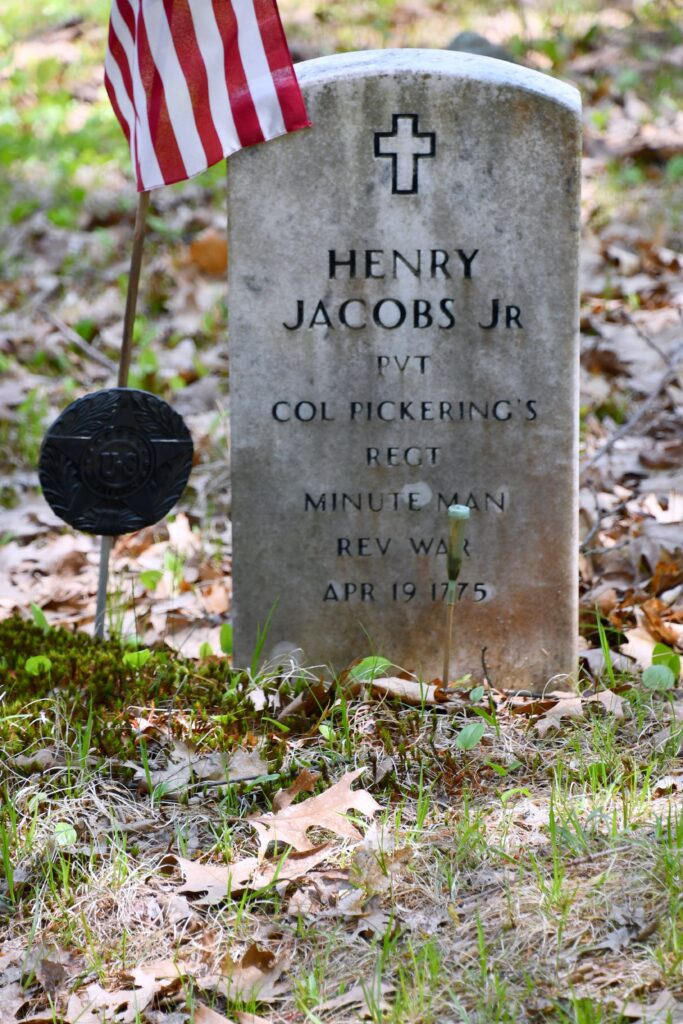
Henry Jacobs Headstone, Modern Replacement, Photographed by Cheryl Millard
Henry Jacobs fought on April 19th, at the Battle of Menotomy, with his younger brother John at his side. Henry was shot in the thigh and lay under some brush to avoid the enemy. When he was discovered by British troops, he reportedly asked for mercy and was bayoneted instead. He was only 22 when he was killed. The deceased soldiers were transported back to Peabody and Danvers by oxcart. Henry Jacobs were taken to the home of Samuel Cook on 65 Central Street, to be waked. The funeral services took place in the South Congregational Church. He was buried at the Jacobs Family Cemetery, adjacent to today’s Lalikos Park.
Private Primus Jacobs
Primus Jacobs was a Black soldier from Danvers who fought with the Continental Army. He fought with Capt. Samuel Page’s Co., Col. Ebenezer Francis’s regiment from March 21, 1777 to Dec. 31, 1779. He served under Major William Lithgow’s Co., Col. Benajamin Tupper’s Regiment from January 1st, 1780, to March 21, 1780; He was reported discharged March· 21, 1780; also, return of men raised in Essex Co. for Continental service, agreeable to resolve of Dec. 2, 1780; engaged for town of Danvers; engaged July 3, 1781. Primus Jacobs and Dinah Smith married on March 20, 1776.
Captain Eleazar Lindsay, Jr. (1714-1782)
Captain Eleazar Lindsay, Jr. was born in 1714 and served in the French and the Indian War as well as the American Revolution. He was a captain at the Battle of Lexington with a company from Lynn. He was also a captain in Colonel Gerrish’s regiment. He died in 1782.
Major Caleb Lowe (1739-1810)
Major Caleb Lowe was born July 7, 1739. He served in the French and Indian War at Fort Ticonderoga. He was the captain of the company that marched on the alarm on April 19, 1775, served under Col. Henry Herrick’s 8th Essex Co., Captain Jeremiah Putnam’s Co., Col. Nathaniel Wade’s Regiment. He was present at the execution of the spy Major Andre. He died May 13, 1810, and was buried at the Old South Burying Ground.
Private Milan Murphy (1752-1827)
Private Milan (Miland/Mylon) Murphy was born in 1752. He served a Black soldier who fought for Danvers in the Continental Army under Col. Colonel Benjamin Tupper’s (10th) Regiment for 22 months, starting on February 22nd, 1781. He is listed on the 1800 Census as “all other free persons”. He married Hepzibah Johnson on February 16, 1802, in Andover. He died on February 11, 1827.
Captain Johnson Proctor (1765-1851)
Captain Johnson Proctor was born to John Proctor and Ruth Rea on October 29th, 1765. When John died, Ruth remarried Oliver Whiting of Tewksbury. He was a loyalist and when the American Revolutionary War broke out, Ruth left her husband returned to Peabody with Johnson. In 1780, Johnson enlisted at 15 years without his mother’s permission. He served under Col. Nathaniel Wade Regiment, with 3 months service at West Point. Johnson was detailed with 5 others to row George Washington across the Hudson, the day before the capture of spy Major Andre. He recalled later George Washington’s stern countenance. He married Lydia Waters in 1789 and took over the Proctor family Inn and Tavern on Lowell Street. He served General Gideon Foster during the War of 1812. When he died on November 11, 1851, he was the last surviving Peabody man who served in the American Revolution.
Private Scipio Shaw
Scipio Shaw married Filis on August 22, 1777, he was listed as a servant to the widow Hannah Shaw. His wife Filis was listed as a servant to widow Elisabeth Buxton. Private Shaw was a Black soldier who served in the Continental Army under Capt. John King’s (9th) co., Col. Benjamin Ruggles Woodbridge’s (25th) regt. He enlisted on June 14th, 1775; his company returned to Cambridge Camp, Sept. 29, 1775; He served under Lieutenant Col Thomas Nixon’s (4th) Regt and Col. Butler’s Co. from September to December 1776; also, Shaw enlisted on August 25, 1777 with Capt. Samuel Flint’s Co., Col. Samuel Johnson’s Regt. Shaw was discharged November 1, 1777 and was compensated for his mileage home, of 260 miles traveled.
Private George Southwick
George Southwick marched with the minutemen on April 19, 1775. He was desperate to find a substitute as his wife was close to giving birth to their child. However, he could find none. He was part of the hand to hand combat the Jason Russell House in Menotomy (now Arlington). He was decapitated by a British soldier. He was only 22 years old.
Private Pomp Symonds
Pomp Symonds was a Black soldier who fought in the Continental Army for Danvers. He was sworn in on February 14, 1778 and served under Capt. Winship and Col. Putnam, term of 3 years. He was also reported as serving under Capt. Caleb Lowe’s 2d and Capt. Job Whipple as well as Col. Rufus Putnam. He was on the muster rolls for January and April 1781. He reported on command for light infantry in April 1781. He was a Private.
Private Primus Trask
Private Primus Trask was a Black soldier from Danvers who served in the Continental Army. He served under Captain Butler’s Co., October-November 1776, as well as Lieut. Col. Nixon’s 4th regiment, January 1777. Trask was compensated for travel over 340 miles from home. He served under Capt. Samuel Flint Co., Col. Samuel Johnson regiment; he enlisted August 25, 1777, discharged November 30, 1777. He had 260 miles compensation. He then served under Capt. Andrew Woodberry Co., Lieut. Col. Enoch Hallet’s regiment; he entered service August 9, 1780 and discharged October 29, 1780.
Captain Dennison Wallis (1756-1825)
Captain Dennison Wallis was born in Ipswich in 1756 and raised in Danvers (now Peabody). Wallis joined the local minutemen as they gathered at the Old Bell Tavern (image below), at the corner of Washington and Main Streets, on April 19, 1775. From there, the local minutemen marched to Lexington and Concord. They engaged with British soldiers at the Village of Menotomy (now Arlington) as the British retreated from Lexington to Boston. Outnumbered, the Danvers men hid in the house of Jason Russell. Once they felt it was safe, they left the home. Wallis was with Joseph Bell and George Southwick. They were ambushed by the British soldiers. Wallis was shot at least 13 times. He survived by pretending to be dead. In January 1776, he applied to the Legislature for aid from wounds he received at Menotomy and was given compensation. After the war, Wallis was a privateer and assisted in the capture of a British transport. Professionally, he was a tanner, who worked on what is today Wallis Street (so named in 1843). He lived in a three-story brick building at 94 Main Street, between what is today the Peabody Institute Library and the Knights of Columbus building, as seen above circa 1900. He left an endowment for a school in District #1, which ultimately led to the Wallis School on Sewall Street being named on his behalf.
Private Jonathan Wilson III (1756-1815)
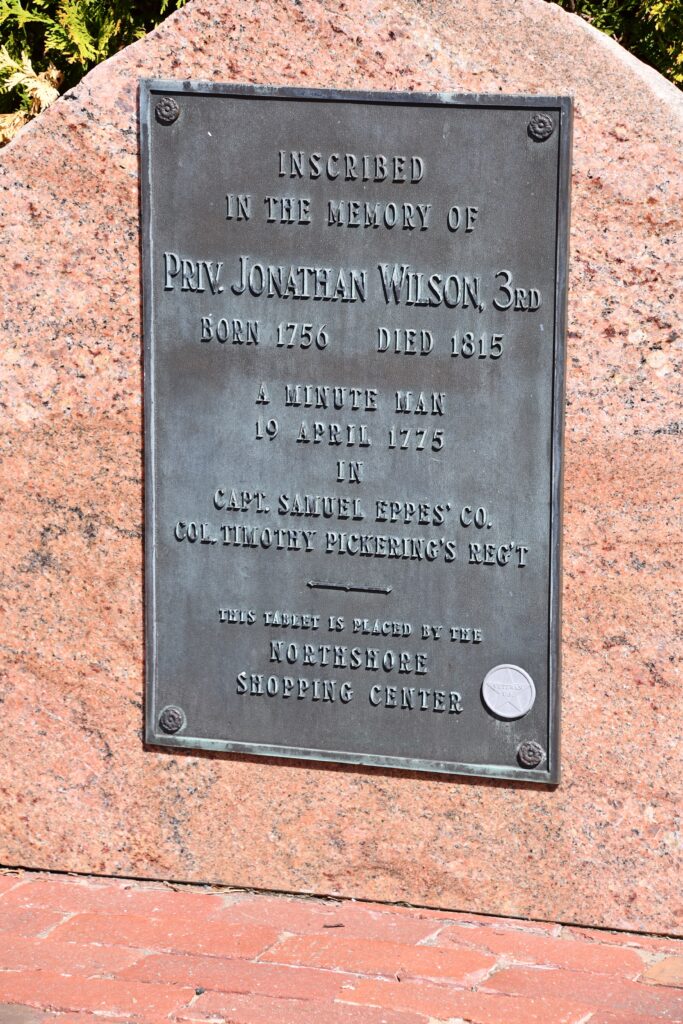
Jonathan Wilson Memorial, Photographed by Cheryl Millard
Private Jonathan Wilson III was born in 1756. He was a Minuteman on April 19, 1775, in Captain Samuel Epes Co., Col. Timothy Pickering. Along with Job Wilson, Robert Wilson, Isaac Wilson, Jonathan Wilson III was buried on the site of today’s North Shore Mall. When the North Shore Shopping Center opened in 1958, his remains were re-interred and a memorial tablet was placed. He died in 1815.
Major Jacob Bancraft Winchester (1762-1842)
Major Jacob Bancraft Winchester was born in Southborough, Massachusetts on July 6, 1762, to William and Hannah (Parker). In 1776, at the age of 14, he served with his father Captain Willam Winchester. In total, he served 7 years, including at Valley Forge and the light infantry brigade of General Lafayette at the taking of Yorktown. He moved to Peabody where he was a soap and candle manufacturer, as well as inn holder of the Bell Tavern. He married Elizabeth Learned in 1786. He died on August 24, 1842.
The Old South Burying Ground (1689-1889)
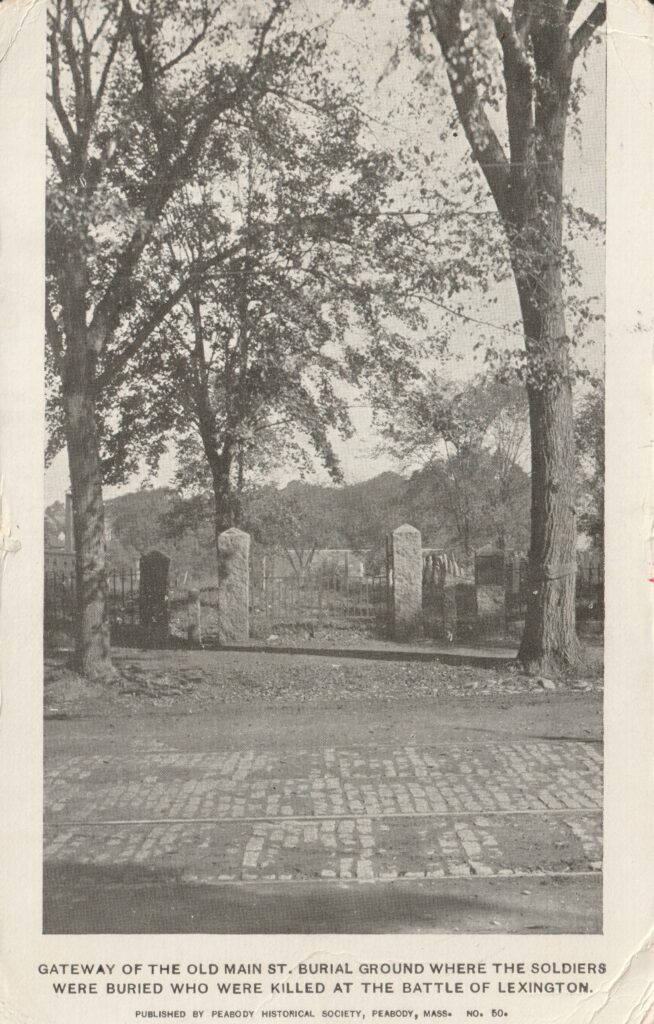
Old South Burying Ground, 1905
The Old South Burying Ground has been known by several names in its history: Boston Street Burying Ground, Old Burying Ground, South Burying Ground, Danvers Ground, Main Street Cemetery and the Trask Burying Ground. The land can be traced back to one of the original English settlers in Salem, Captain William Trask. Trask emigrated in 1628 and established the first milling operation and glasshouse in the area. The cemetery land was given to the Town by William Trask’s descendent, Lydia Trask, around 1750. The oldest headstone in the cemetery dates to 1689, belonging to Lucreatia Derby (1643-1689). Her husband Roger Derby was also buried here in 1698. When the main road was widened in the early nineteenth century, a fence was placed around the burial ground. As a consequence, four of the seven South Danvers men who sacrificed their lives at the Battle of Lexington are now believed buried beneath the sidewalk or the roadway, following later construction. In 1896, the Peabody Historical Society placed a bronze plaque to commemorate their lives Later, the City Veterans Agent arranged special recognition of the four by obtaining the white veteran grave markers now in place.
American Revolutionary Soldiers Buried at the Old South Burying Ground
Samuel Cook, Jr. (1742-1775), died at the Battle of Menotomy, April 19, 1775
Benjamin Daland, Jr. (1750-1775), died at the Battle of Menotomy, April 19, 1775
Ebenezer Goldthwait (1753-1775), died at the Battle of Menotomy, April 19, 1775
George Southwick, Jr. (1750-1775), died at the Battle of Menotomy, April 19, 1775
Captain Dennison Wallis (1756-1825), injured on April 19, 1775 at the Battle of Menotomy
Major Caleb Low (1740-1810), Captain of company that marched on the alarm on April 19, 1775, served under Col. Henry Herrick’s 8th Essex Co., Captain Jeremiah Putnam’s Co., Col. Nathaniel Wade’s Regiment
First Lieutenant Benjamin Jacobs (1741-1814), Captain Samuel Epes’s Co., Col. Pickering’s Regiment, marched on the alarm of April 19, 1775, served under Captain Caleb Low’s 3rd Company, Co, Col. Henry Herrick’s 8th Essex Co., Col. Nathaniel Wade’s Regiment
Captain Ebenezer Sprague, Jr. (1760-1855), Captain Caleb Low’s Co, marched on the alarm on April 19, 1775
Robert Shillaber (1736-1808), Private, Captain Caleb Low’s Co, marched on the alarm on April 19, 1775
David Felton (1757-1818), Private, Captain Jeremiah Page’s Co.
Jacob Reed (1754-1825), Private, Poor’s New Hampshire Regiment
William Southwick (1753-1828), Private, Captain Samuel Epes Co.
Samuel Peabody (1757-1839), Private, Captain Stephen Websters’ Co., Col. Jacob Gerrish Regiment
Captain Silas Smith (1730-1806), commander of the schooner Fly, 1780
Lexington Monument
The Lexington Monument, now at the corner of Washington and Sewall Streets, honors the Peabody and Danvers men who gave their lives at the first battle of the American Revolution: Samuel Cook, Henry Jacobs, Ebenezer Goldthwaite, Benjamin Daland, Jotham Webb and Perley Putnam. At the time of their deaths, the men were all young, with much life before them. Samuel Cook was 33. George Southwick and Benjamin Daland were 25. Henry Jacobs, Ebenezer Goldthwaite and Jotham Webb were 22. Perley Putnam, the youngest, was 21. The Lexington Monument exists today because a group of citizens recognized the importance of a permanent memorial to the fallen men of April 19, 1775. In 1834, led by John Upton, a committee was formed make it happen. The local community responded with generous individual donations – ranging from $1 to $15. Philanthropist George Peabody donated the final $100 to make sure the monument was completed. The corner stone of the monument was laid on Monday, April 20th, 1835 – the 60th anniversary of the Battle of Lexington. 19 men, who had fought in the Battle of Lexington, were present at the ceremony. These surviving soldiers placed a box under the cornerstone, containing memorial items and documents. Of these men, 12 were from Peabody and Danvers: Gideon Foster, Sylvester Osborne, Johnson Proctor, Levi Preston, Asa Tapley, Roger Nourse, Joseph Shaw, John Jocelyn, Ephram Smith, Jonathan Porter, Joseph Tufts and William Flint. The remembrances concluded at the Old South Church, which was overflowing with people. The monument is made of stone quarried off Summit Street. The Brown family quarried and cut the stone. The monument was designed by Asher Benjamin. On the 100th Anniversary of the Battle of Lexington, another large ceremony took place. General Ulysses S. Grant, then President of the United States, attended the event. A group of Peabody and Danvers men retraced the steps of the minutemen and marched to Lexington. The Lexington Monument stood at its original location until 1968.
The below images of the Lexington Monument date to circa 1900.
There was a serious automobile accident in 1964, where the driver lost control of his vehicle and crashed into the monument. Many grew concerned over the monument’s proximity to the busy street. It was moved back a few yards in 1968, but still posed an issue. The City of Peabody wanted to relocate it but struggled to find an appropriate spot. There were multiple ideas, including moving it to Cedar Grove Cemetery. Ultimately, it was moved back 25 feet to its current location at the corner of Washington and Sewall Streets on August 29, 1985.
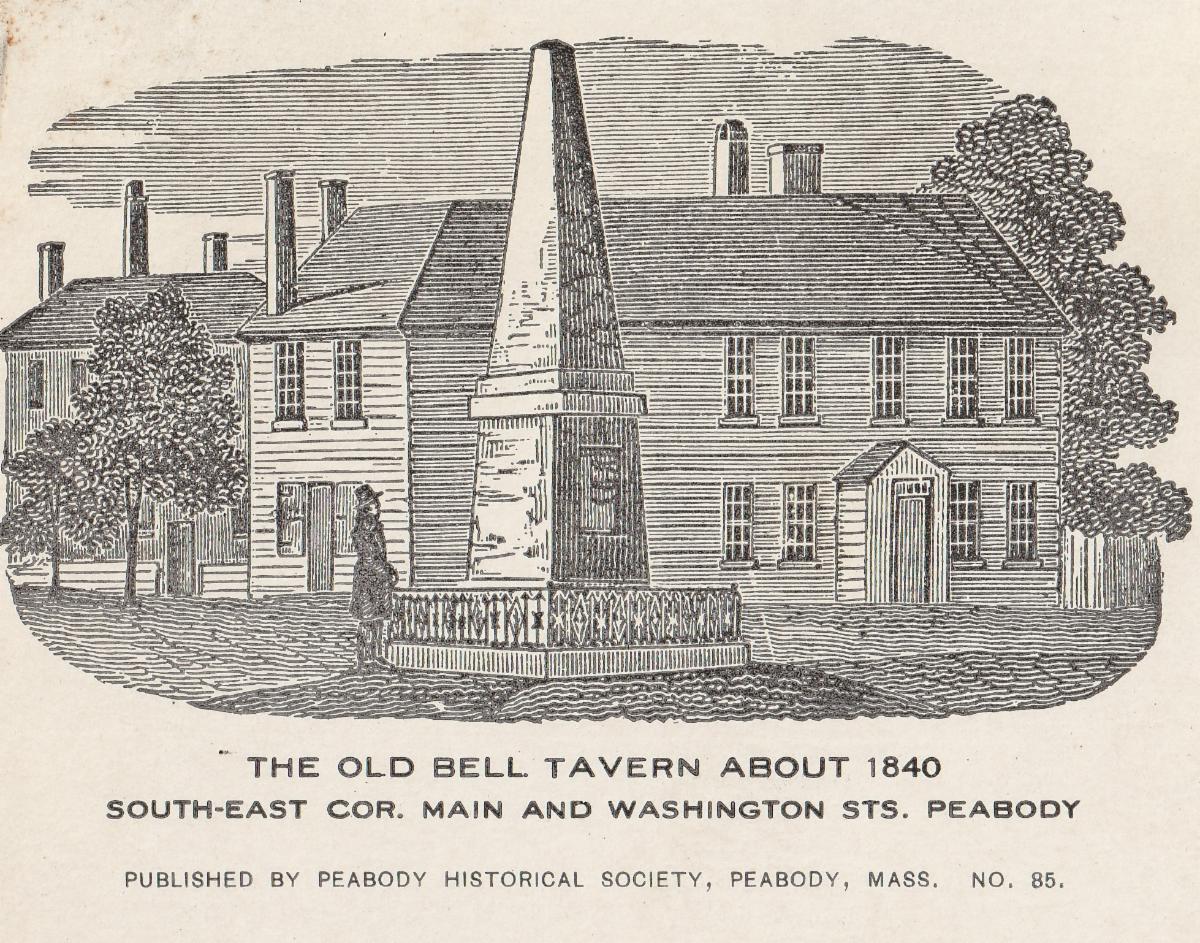
Bell Tavern-2 Washington Street
The original Bell Tavern was built in 1757 by Francis Symonds, who also operated Peabody’s first printing press out of his buildings on Main Street. The Bell Tavern was a place for travelers to stay, eat and drink on their journey. In 1775, the local militia met in front of the Bell Tavern on April 19th to march to Lexington and Concord. After 4 hours and 16 miles, they reached the village of Menotomy (the city of Arlington today). It was here that the minutemen encountered the retreating British soldiers. These Danvers (now Peabody) men were killed in battle that day: George Southwick, Samuel Cook, Henry Jacobs, Ebenezer Goldthwaite, and Benjamin Daland. The American Revolution began that day, and for these men, their day started at the Bell Tavern. In 1835, the Lexington Monument was built in their memory. The Monument, now moved, stood on Main Street across from the Bell Tavern.
The Bell Tavern was also the location of an important printing press during the 18th century, as seen below.
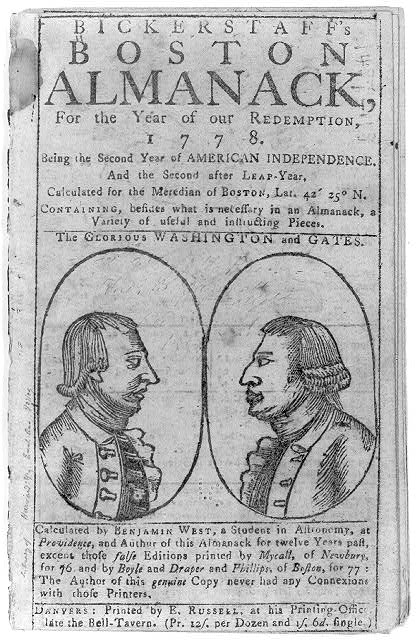
Courtesy of the Library of Congress; Bickerstaff’s Boston Almanack, printed at the Bell Tavern, by E. Russell (Danvers, now Peabody), 1778.
This page was researched and compiled by Curator Nora Bigelow. If you have any edits or suggestions, please reach out to Nora.Bigelow@peabodyhistorical.org.
References
Military, Birth and Death Records, Ancestry.com
Miscellaneous Archives of the Peabody Historical Society and Museum.
Captain Samuel Flint and William Flint, by D. Webster King, Thirteenth Report of the Peabody Historical Society, 1908-1909 (Read originally April 19, 1898).
Massachusetts Soldiers and Sailors in the War of the Revolution. Prepared and Published by the Secretary of the Commonwealth, 1899.
Municipal History of Essex County, ed. Benjamin Arrington, Lewis Historical Publishing Company, 1922, pages 559 and 819.
John Wells. The Peabody Story. Essex Institute, 1972.
Troy Smith. “Battle of Saratoga.” Accessed April 3, 2024. In The Digital Encyclopedia of George Washington. Retrieved from https://www.mountvernon.org/library/digitalhistory/digital-encyclopedia/article/battle-of-saratoga/#:~:text=The%20Battle%20of%20Saratoga%20fought,career%20of%20General%20George%20Washington.

